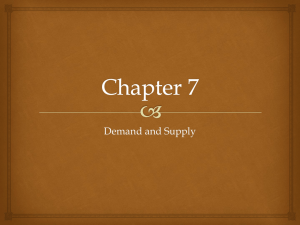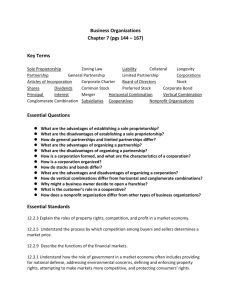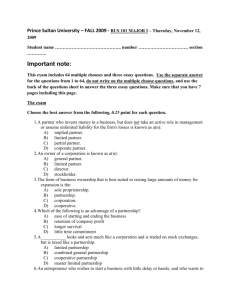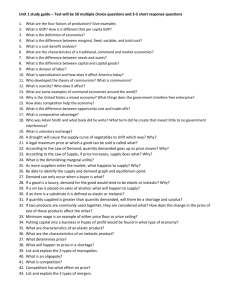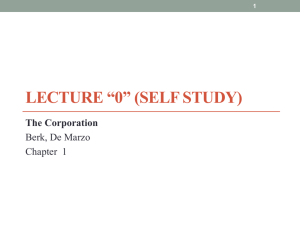Economics Final Review
advertisement
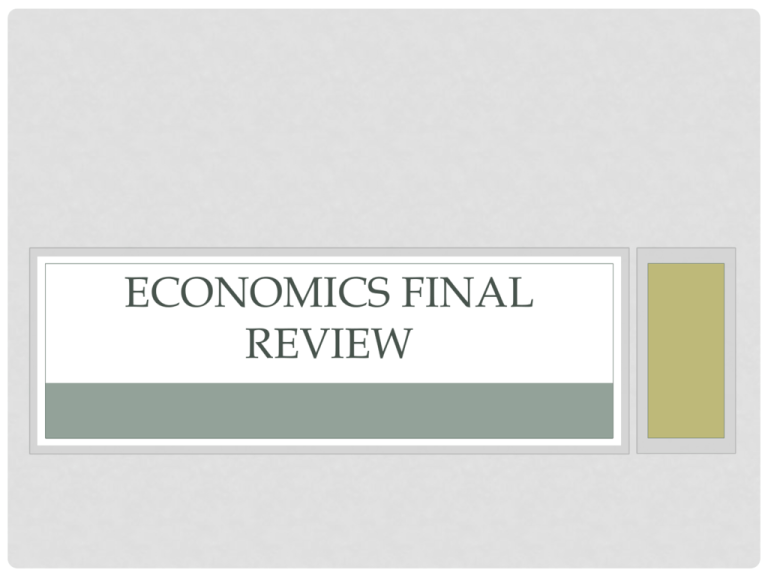
ECONOMICS FINAL REVIEW FACTORS OF PRODUCTION • Land, labor, and capital: all the resources that are used to make all goods and services ECONOMICS • The study of how people seek to satisfy their needs and wants by making choices TRADEOFFS • An alternative we sacrifice when we make a decision • ie: more time at work less time to watch tv PHYSICAL CAPITAL • Capital-All human made goods that are used to produce other goods and services, • tools and buildings are physical capital HUMAN CAPITAL • The skills and knowledge gained by a worker through education and experience • Human and physical capital needed in an economy BASIC ECONOMIC DECISION • What to produce? • How to produce? • How to Finance? GUNS OR BUTTER • The phrase that refers to the tradeoff that a nation makes when choosing to produce more military supplies or consumer goods PRODUCTION POSSIBILITIES FRONTIER • The line on a production possibilities graph that shows the maximum level of output WHAT IS DEMAND? The law states that all other factors being equal, as the price of a good or service increases, consumer demand for the good or service will decrease. • A table that lists the quantity of a good that a person will purchase at each price in a market. • Shows the quantities demanded at each price by all consumers in the market. • A small change in price buy much less of a good. • Elastic determines if a change in price will affect your demand for the product. • A consumer with highly elastic demand for a good is very responsive to price changes. • Demand for a good that you will keep buying despite a price increase. • Inelastic determines if a change in price does not affect your demand for the product. • A consumer with highly inelastic demand for a good relatively unresponsive to price changes. LAW OF SUPPLY • Supply- the amount of goods available • According to the law of Supply the higher the price, the larger the quantity produced • Quantity Produced- economic term to describe how much of a good is offered at a specific price • Elasticity of supply is a measure of the way quantity supplied reacts to a change in price. • If supply is not very responsive to changes in price, it is considered inelastic. • An elastic supply is very sensitive to changes in price. WHAT AFFECTS ELASTICITY OF SUPPLY? Time In the short run, a firm cannot easily change its output level, so supply is inelastic. • In the long run, firms are more flexible, so supply can become more elastic. THE SUPPLY SCHEDULE • Supply schedule shows the relationship between price and quantity supplied for a certain good • Like a demand schedule a supply schedule lists supply for a very specific set of conditions • A rise or fall in the price will change the quantity supplied but not the schedule MARKET SUPPLY SCHEDULES • The relationship between price and the total quantity supplied by all suppliers in market Market Supply Schedule Price per slice of pizza Slices supplied per day $.50 $1.00 1,000 1,500 $1.50 2,000 $2.00 2,500 $2.50 3,000 $3.00 3,500 NYSE • New York Stock Exchange • The New York Stock Exchange (NYSE): handles the most powerful and established companies THE DOW JONES INDUSTRIAL AVERAGE • Stock performance is reported in the Dow Jones Industrial Average. • The Dow Jones Industrial Average is usually referred to as the Dow. • The Dow monitors and reports generally on the trading activities of thirty of the most powerful companies. BULL AND BEAR MARKETS • A bull market occurs when the stock market rises steadily over a period of time. • A bear market occurs when the stock market falls over a period of time. • Stock indexes, like the Dow, allow investors to track the progress of the stock market. SOLE PROPRIETORSHIP • A sole proprietorship is a business owned and operated by an individual. • Most businesses in the United States are sole proprietorships. • However, sole proprietorships account for a small percentage of total sales in the U.S.A. CORPORATION • A corporation is a legal entity owned by individual stockholders. • A corporation is considered a separate entity apart from its owners. • As such, the corporation can be sued but individual stockholders cannot be sued. A business cycle is a period of macroeconomic expansion followed by a period of contraction. THE FOUR PHASES OF A BUSINESS CYCLE There are four phases in a business cycle: Expansion: a period of economic growth Peak: the height of the expansion Contraction: a period of economic decline Trough: the lowest point of the contraction RECESSIONS AND DEPRESSIONS • Each phase of the business cycle is determined by monitoring Gross Domestic Product. • A contraction that lasts for at least six months is called a recession. • A particularly severe and long contraction is called a depression. THE EFFECT OF RISING PRICES • Inflation- is a general increase in prices • Over the years prices rise and fall, but in the American economy they have mostly risen • Purchasing Power- the ability to purchase goods and services BONDS • Bonds are loans. • An investor loans money to a corporation or a government. • The corporation or government must repay the loan with interest. RISK AND PROFIT • Investors risk their money hoping to make more money. • High-risk investments are investments that are more likely to fail. • However, higher risk leads to greater profits. Remember, trade-offs! CHARACTERISTICS OF A GOOD TAX • A good tax has the following characteristics: • Simplicity • Tax laws should be simple and easily understood. • Economy • Government administrators should be able to collect taxes without spending too much time or money. • Certainty • It should be clear to the taxpayer when the tax is due, how much is due, and how it should be paid. • Equity • The tax system should be fair, so that no one bears too much or too little of the tax burden. THREE USES OF MONEY Money is a medium of exchange, a unit of account, and a store of value. As a medium of exchange, money measures value during the exchange of goods and services. What is the value of a sweater? MEDIUM OF EXCHANGE • Anything used to determine value during the exchange of goods or services • Barter- the direct exchange of one set of goods or services for another MONEY, AGAIN As a unit of account, money is a way to compare the value of goods and services. A more expensive sweater is considered more valuable than a cheaper sweater. Finally, money is a store of value. Money holds its value even if it is not used though inflation affects money. SIX CHARACTERISTICS OF MONEY Do we use pigs as money or paper as money? How does a society decide? There are six characteristics of good money. Money should be portable, divisible, durable, uniform, accepted, and have a limited supply. Too much money in circulation means less value. • Inferior Goods- Goods for which demand falls when income rises • Durable Goods= goods that last for a relatively long time(used car) • Non-Durable Goods -that last a relatively short period( paperback book) MARKET ECONOMY • Economic system where decisions are based on voluntary exchanges of the market • U.S. is a market economy CETERIS PARIBUS • All other things being equal, only takes price into account • Fringe Benefits- a payment other than wages or salaries • Bank Run- more customers withdraw money than the bank has on hand REPRESENTATIVE MONEY • objects that have value and can be exchanged for something else of value • Example: IOU FEDERAL RESERVE • If the Fed wants to encourage banks to loan out more of their money, it may reduce the discount rate, making it easier • Federal Reserve Districts- !2 FDIC • To make sure customers do not lose money if a bank fails VERTICAL MERGER • A joining of two or more businesses involved in different stages of producing the same good or service POSSIBLE SHORT ESSAY TOPICS • Characteristics of Money • • • • • • Durability- must withstand wear and tear over time Portability-can be easily transferred Divisibility-must be easily divided into smaller denominations Uniformity-must be easy to count and measure accurately Limited- the right amount must be in supply Accepted – people will accept for goods and services • Functions of the Federal Reserve • • • • Serves Gov’t as nations banker Serves banks by lending money Regulates banking system Regulates the money supply POSSIBLE • Functions of Money • Medium of Exchange- determines value during exchange of goods and services • Unit of Account- provides a means of comparing values • Store of Value- keeps its value over time Characteristics of a Good Tax Simplicity- should be easily understood Efficiency- gov’t should be able to collect taxes easily Certainty- clear when tax is due, and how it will be paid Equity-tax system should be fair
